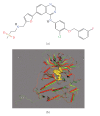Anti-EGFR Therapy: Mechanism and Advances in Clinical Efficacy in Breast Cancer
- PMID: 19390622
- PMCID: PMC2668926
- DOI: 10.1155/2009/526963
Anti-EGFR Therapy: Mechanism and Advances in Clinical Efficacy in Breast Cancer
Abstract
This review will focus on recent advances in the application of antiepidermal growth factor receptor (anti-EGFR) for the treatment of breast cancer. The choice of EGFR, a member of the ErbB tyrosine kinase receptor family, stems from evidence pinpointing its role in various anti-EGFR therapies. Therefore, an increase in our understanding of EGFR mechanism and signaling might reveal novel targets amenable to intervention in the clinic. This knowledge base might also improve existing medical treatment options and identify research gaps in the design of new therapeutic agents. While the approved use of drugs like the dual kinase inhibitor Lapatinib represents significant advances in the clinical management of breast cancer, confirmatory studies must be considered to foster the use of anti-EGFR therapies including safety, pharmacokinetics, and clinical efficacy.
Figures




Similar articles
-
Lapatinib: a dual inhibitor of human epidermal growth factor receptor tyrosine kinases.Clin Ther. 2008 Aug;30(8):1426-47. doi: 10.1016/j.clinthera.2008.08.008. Clin Ther. 2008. PMID: 18803986 Review.
-
Small molecule inhibitors targeting the EGFR/ErbB family of protein-tyrosine kinases in human cancers.Pharmacol Res. 2019 Jan;139:395-411. doi: 10.1016/j.phrs.2018.11.014. Epub 2018 Nov 27. Pharmacol Res. 2019. PMID: 30500458 Review.
-
Lapatinib: a small-molecule inhibitor of epidermal growth factor receptor and human epidermal growth factor receptor-2 tyrosine kinases used in the treatment of breast cancer.Clin Ther. 2009;31 Pt 2:2332-48. doi: 10.1016/j.clinthera.2009.11.029. Clin Ther. 2009. PMID: 20110044 Review.
-
The ErbB/HER family of protein-tyrosine kinases and cancer.Pharmacol Res. 2014 Jan;79:34-74. doi: 10.1016/j.phrs.2013.11.002. Epub 2013 Nov 20. Pharmacol Res. 2014. PMID: 24269963 Review.
-
Anti-epidermal growth factor receptor therapy for glioblastoma in adults.Cochrane Database Syst Rev. 2020 May 12;5(5):CD013238. doi: 10.1002/14651858.CD013238.pub2. Cochrane Database Syst Rev. 2020. PMID: 32395825 Free PMC article.
Cited by
-
Inhibition of EGFR-AKT axis results in the suppression of ovarian tumors in vitro and in preclinical mouse model.PLoS One. 2012;7(8):e43577. doi: 10.1371/journal.pone.0043577. Epub 2012 Aug 27. PLoS One. 2012. PMID: 22952709 Free PMC article.
-
New Thiazolyl-Pyrazoline Derivatives as Potential Dual EGFR/HER2 Inhibitors: Design, Synthesis, Anticancer Activity Evaluation and In Silico Study.Molecules. 2023 Nov 6;28(21):7455. doi: 10.3390/molecules28217455. Molecules. 2023. PMID: 37959874 Free PMC article.
-
Dual inhibition of EGFR at protein and activity level via combinatorial blocking of PI4KIIα as anti-tumor strategy.Protein Cell. 2014 Jun;5(6):457-68. doi: 10.1007/s13238-014-0055-y. Epub 2014 May 7. Protein Cell. 2014. PMID: 24801752 Free PMC article.
-
Targeted Liposomal Chemotherapies to Treat Triple-Negative Breast Cancer.Cancers (Basel). 2021 Jul 26;13(15):3749. doi: 10.3390/cancers13153749. Cancers (Basel). 2021. PMID: 34359650 Free PMC article.
-
Cryo-EM structures of PI3Kα reveal conformational changes during inhibition and activation.Proc Natl Acad Sci U S A. 2021 Nov 9;118(45):e2109327118. doi: 10.1073/pnas.2109327118. Proc Natl Acad Sci U S A. 2021. PMID: 34725156 Free PMC article.
References
-
- Moy B, Goss PE. Lapatinib: current status and future directions in breast cancer. Oncologist. 2006;11(10):1047–1057. - PubMed
-
- Boyd MC. A Literature Review Submitted to the Program for Biochemistry and Molecular Biology at New York Medical College in Partial Fulfillment of the Requirements for the Degree of Master of Science. Valhalla, NY, USA: Laboratory of Dr. Joseph Wu, New York Medical College; 2005. Epidermal growth factor receptor: structural basis for functional properties.
-
- Gotoh N, Tojo A, Hino M, Yazaki Y, Shibuya M. A highly conserved tyrosine residue at codon 845 within the kinase domain is not required for the transforming activity of human epidermal growth factor receptor. Biochemical and Biophysical Research Communications. 1992;186(2):768–774. - PubMed
-
- Konecny GE, Pegram MD, Venkatesan N, et al. Activity of the dual kinase inhibitor lapatinib (GW572016) against HER-2-overexpressing and trastuzumab-treated breast cancer cells. Cancer Research. 2006;66(3):1630–1639. - PubMed
-
- Agrawal A, Gutteridge E, Gee JMW, Nicholson RI, Robertson JFR. Overview of tyrosine kinase inhibitors in clinical breast cancer. Endocrine-Related Cancer. 2005;12(supplement 1):S135–S144. - PubMed
LinkOut - more resources
Full Text Sources
Other Literature Sources
Research Materials
Miscellaneous

